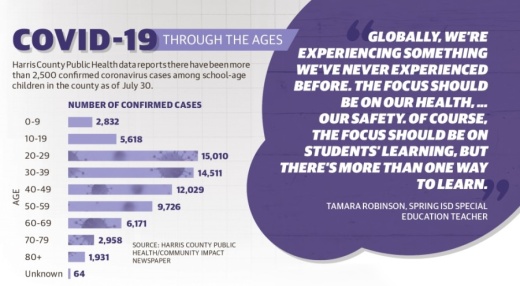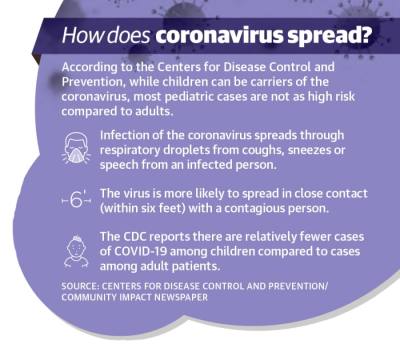School districts in the Spring and Klein area have delayed the start date for in-person instruction until after Labor Day and have offered families the opportunity to choose if their student will attend classes in-person in person or virtually this fall.
Looking back on the virtual ending to the 2019-20 school year, Spring ISD special education teacher Tamara Robinson said as an educator, the experience was a tough one.
“[Educators] didn’t have good participation by the students or parents as far as logging the students on to continue assignments or responding back to our phone calls or emails,” Robinson said.
Despite the difficulty of adjusting to last year’s unexpected switch to a virtual learning model, however, Robinson said she believes the current state of the coronavirus pandemic suggests in-person instruction is still too risky to execute for the upcoming school year.
“Globally, we’re experiencing something we’ve never experienced before,” she said. “The focus should be on our health, ... our safety. Of course, the focus should be on students’ learning, but there’s more than one way to learn.”
However, some Spring- and Klein-area parents feel virtual learning fails to compare with in-person education, such as Klein ISD parent Gil Lopez.
“I feel strongly that kids need to be in school and not at home online,” Lopez said. “Yes, they must be safeguarded. However, the rest of us need to move on and stop the nonsense.”
Despite not all residents being in favor of pursuing virtual education in the upcoming school year, state and local leaders have released guidance for school districts to implement online learning in hopes of curbing the spread of the coronavirus in schools.
Extending online only
Local leaders have urged public schools to consider holding off in-person education. In a July 20 letter, Harris County Judge Lina Hidalgo and Dr. Umair Shah, Harris County Public Health executive director, recommended schools wait to return to in-person instruction until at least October.
“We recognize that in-person instruction is vital for the educational development and social well-being of children and young adults,” the letter reads. “However, the prevalence of the virus in our community means that it would be unsafe for schools to return in-person at this time or in the near future.”
The letter came following the Texas Education Agency’s guidance issued in mid-July giving Texas school districts the option to offer virtual learning for the first four weeks of instruction in the 2020-21 school year with an additional four weeks if needed.
Dr. Anu Seshadri, an internal medicine and pediatric physician at the University of California in Los Angeles, said schools and their families should refer to guidelines issued by the Centers for Disease Control and Prevention and the American Academy of Pediatrics, which strongly recommend children participate in in-person education.
Seshadri said children are not usually considered high-risk cases.
“When it comes to transmission or the risk of the impact COVID[-19] has on a child, children are the largest group of asymptomatic carriers,” Seshadri said. “When they do get infected with COVID-19, most of them don’t even show any symptoms—at least for now.”
Among cases where age was reported, Harris County Public Health data shows more than 8,500 confirmed coronavirus cases were among school-age children in the city of Houston and Harris County as of July 30 out of 70,850 total cases.
Despite this, children can still be carriers of the virus, and as a result Seshadri recommended schools enforce social distancing practices and facial coverings, as well as remain flexible enough to respond to situations such as a coronavirus outbreak.
Staying flexible
In response to recently released guidelines from state and local entities, school districts are now offering families the opportunity to choose from virtual and in-person learning options for the coming year.
SISD classes are still scheduled to begin Aug. 17; however, students will participate in online-only learning for the first month of the school year. District families were given an Aug. 7 deadline to select in-person or remote learning options for the first grading period of the school year.
The decision to delay the start date for in-person education follows the district’s Operational Decision Maker, a tool based on Harris County’s COVID-19 Threat Level system that is used to determine the virus’s threat level to the district.
“Based upon [Hidalgo’s] recommendation, we will be starting our first four weeks of school in remote [learning],” SISD Superintendent Rodney Watson said during a July 20 meeting.
Following suit, KISD will also require students to start the year entirely online Aug. 19 until at least Sept. 9. According to a July 22 KISD statement, the return to in-person learning will be dependent on the coronavirus’s progression in the area.
For students who enroll in virtual education, all academic learning and coursework will be completely online, accessible from home and facilitated by KISD teachers using the Schoology online virtual classroom service, according to a July 10 release from KISD.
Students will be required to have at-home internet access and access to a device such as a tablet or laptop to participate in the remote learning option, which will include periods of live virtual instruction and self-paced, independent learning.
Students who choose in-person education will be required to wear facial coverings when social distancing in schools is not possible and it is deemed developmentally appropriate, according to the release.
Cy-Fair ISD has postponed the start date of the 2020-21 school year from Aug. 24 to Sept. 8, and families had until Aug. 5 to decide if students would attend in-person or online classes for the first grading period of the new year.
According to CFISD Superintendent Mark Henry, the decision gives the district time to gather the needed digital resources for students for the upcoming year, as well as allow the virus’s spread to slow.
“I’ll just tell you right up front, there’s no good answer,” Henry said in a July 21 meeting. “If there was a good answer, if there were an easy answer, we would lay it out for you, and everyone would be happy. But there are no perfect answers.”
Demand for digital
To accommodate the new virtual population of students, school districts are also working to fill any technology gaps that may exist among students in preparation for the upcoming 2020-21 school year.
According to BroadbandNow, an online organization that provides localized information and comparisons of internet providers, there are an estimated 129,000 people without any access to wired internet across Harris County.
In the Spring area, including ZIP codes 77373, 77379, 77388 and 77389, roughly 2,000 people have access to one or no internet providers, and the cheapest price families can expect to pay for 100 Mbps at-home internet access—the recommended internet speed for homes with four or more internet users—is $49.99 per month.
SISD is planning to spend more than $3 million to accommodate the school year’s technology needs using funds from nonbond capital projects set aside for technology upgrades for the district, SISD Chief Financial Officer Ann Westbrooks said in an email.
“We plan to purchase additional devices in an effort to achieve a 1:1 ratio of devices for our students in grades 3-12 while also having some devices available for our students in [grades] pre-K-2,” Westbrooks said.
SISD Information Technology Officer Jeff Kohrmann said the district has met 85% of that goal since distributing 11,000 devices to students during the spring semester.
As part of CFISD’s Learning Together Everywhere 1:1 program, district officials have announced plans to invest $44 million to bridge the digital divide. CFISD is in the process of receiving an estimated 80,000 laptops and internet hot spots for those without them.
“Our virtual platform is going to be 10 times better than it was in the spring, and I know many of you are glad to hear that,” Henry said July 21. “But there’s nothing that replaces in-person instruction.”
KISD also distributed loaned laptop devices to intermediate and high school students during the spring semester and expanded Wi-Fi coverage at district facilities to reach nearby homes.
“Through the overwhelming community support of the 2008 and 2015 bond referendums, Klein ISD has long made strategic investments in student and staff technology,” Chief Academic Officer Amy Miller said. “This investment served us well as we were able to deploy devices to qualified families during the initial response to the pandemic.”
Additional reporting by Shawn Arrajj, Danica Lloyd and Hannah Zedaker







